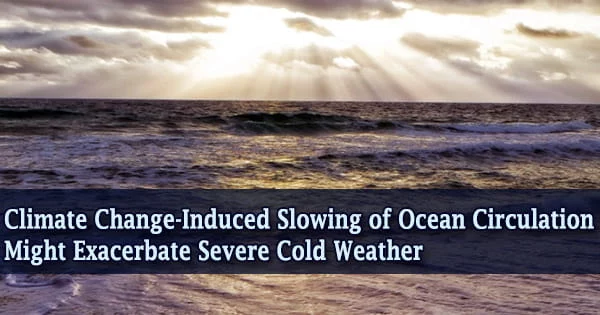A water conveyor belt traverses through the world’s seas; its churning is fueled by temperature and salinity variations in the water, and its activity influences weather patterns all across the world.
The Atlantic part of the global conveyor belt known as the Atlantic Meridional Overturning Circulation, or AMOC, was researched by a pair of researchers, who discovered that the United States’ winter weather is heavily reliant on this conveyor belt-like system. Because of climate change, the AMOC will slow, resulting in more extreme cold winter weather in the United States.
Jianjun Yin, an associate professor in the University of Arizona Department of Geosciences, and Ming Zhao, a physical scientist at the National Oceanic and Atmospheric Administration’s Geophysical Fluid Dynamics Laboratory, led the study, which was published in the journal Communications Earth & Environment.
The magnitude is on the order of 1 petawatts, or 10 to the 15 power watts. Right now, the energy consumption by the entire world is about 20 terawatts or 10 to the 12 power watts. So, 1 petawatt is enough to run about 50 civilizations.
Jianjun Yin
AMOC functions in the following way: In the upper Atlantic Ocean, warm water moves north, releasing heat into the atmosphere at high latitudes. The water becomes thicker as it cools, causing it to sink into the deep ocean and flow back south.
“This circulation transports an enormous amount of heat northward in the ocean,” Yin said. “The magnitude is on the order of 1 petawatts, or 10 to the 15 power watts. Right now, the energy consumption by the entire world is about 20 terawatts or 10 to the 12 power watts. So, 1 petawatt is enough to run about 50 civilizations.”
However, when the temperature warms, the ocean surface heats as well. Simultaneously, the Greenland ice sheet is melting, dumping more freshwater into the ocean. Warming and refreshing the water can diminish the density of the surface water and prevent it from sinking, delaying the AMOC. The northward heat transmission slows as the AMOC slows.
Because the equator receives more energy from the sun than the poles, this is significant. Energy is transported from low latitudes to high latitudes by both the atmosphere and the ocean. If the ocean can’t transfer as much heat northward as it formerly could, the atmosphere at mid-latitudes must transport more heat through more intense weather processes.
Cold air is displaced from the poles and pushed to lower latitudes, reaching as far south as the US southern border, while the atmosphere transports heat northward.
“Think of it as two highways connecting two big cities,” Yin said. “If one is shut down, the other one gets more traffic. In the atmosphere, the traffic is the daily weather. So, if the ocean heat transport slows or shuts down, the weather becomes more extreme.”
The study was prompted by the exceptionally cold weather that Texas endured in February, according to Yin.
“In Houston, the daily temperature dropped to 40 degrees Fahrenheit below the normal,” Yin said. “That’s the typical range of a summer/winter temperature difference. It made Texas feel like the Arctic. This kind of extreme winter weather happened several times in the U.S. during recent years, so the scientific community has been working to understand the mechanism behind these extreme events.”
The Texas crisis resulted in extensive and severe power outages, with the National Oceanic and Atmospheric Administration estimating $20 billion in socioeconomic effects. Yin was intrigued by the ocean’s participation in the dramatic weather occurrence.
To determine the impact of the AMOC on severe cold weather in the United States, Yin and Zhao employed a cutting-edge, high-resolution global climate model.
They ran the model twice, the first time to look at the current climate with a working AMOC. They then tweaked the model by injecting enough freshwater into the North Atlantic’s high latitudes to shut off the AMOC. The AMOC’s involvement in extremely cold weather was demonstrated by the discrepancy. Extremely cold winter weather worsens in the United States without the AMOC and its northward heat transmission, according to the researchers.
The AMOC has diminished in recent decades, according to new observational research. Climate models predict that when greenhouse gas levels rise in the atmosphere, it will become increasingly weaker.
“But there is uncertainty about the magnitude of the weakening because, at this point, we don’t know exactly how much the Greenland ice sheet will melt,” Yin said. “How much it melts depends on the greenhouse gas emissions.”
The researchers also didn’t include in the consequences of human-caused global warming in their model, but Yin says that’s something they’ll look into in the future.
“We basically just turn off the AMOC (in the model) to look at the response by extreme weather,” he said. “Next, we want to factor in the greenhouse gases and look at the combined effects of the AMOC slowdown and global warming on extreme cold weather.”





